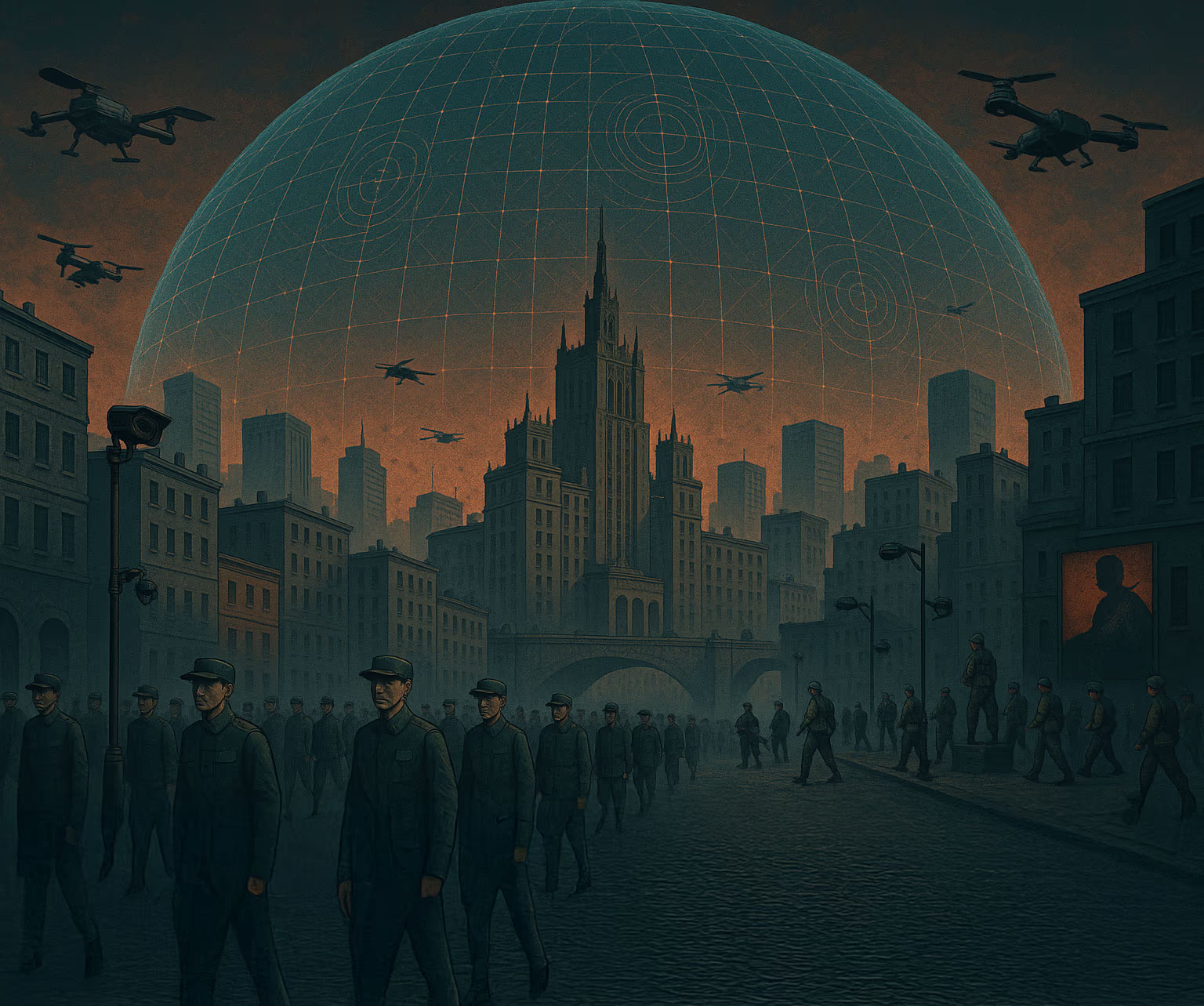Heads of state are increasingly confronted with crises for which their institutions are ill-prepared. When the established order begins to falter, nations fall back on their most reliable and time-tested instrument—the military. Where civilian structures are paralyzed or ineffective, where decisions demand time, deliberation, and accountability, military logic offers clarity: command, resources, execution. Ambitious reforms give way to mobilization. In place of debate comes the state of emergency. Dialogue is replaced with governance framed in terms of threats and enemies.
This shift is driven less by strategic design than by inertia—and a desire to avoid difficult choices. Civilian mechanisms, from parliaments to market economies, are built to function in times of stability. But prolonged and multi-layered crises catch political elites off guard—whether due to confusion, incompetence, or fear of losing control. When decisions are needed everywhere at once, and time, resources, and trust are in short supply, the military becomes the only tool capable of imposing order—or at least projecting its appearance. As a result, the armed forces are increasingly tasked with duties once seen as the domain of civil institutions: patrolling cities, managing logistics, energy and transport, securing borders where civilian agencies falter. In some cases, their mere presence serves as a reminder of power—when authority alone no longer commands trust.
Military mobilization becomes a universal response—not because it offers a solution, but because it removes the need to confront root causes. Militarization turns into a form of political escapism: from dialogue to command, from compromise to suppression, from unpredictable reality to a choreographed theatre of force.
Yet an army capable of preventing immediate collapse cannot stop the unraveling itself. On the contrary, by standing in for long-term solutions, it merely postpones the inevitable—deepening the eventual breakdown when the system finally gives way.
Militarization Displaces Reform. When Civilian Institutions Are Overwhelmed, the Military Claims Resources, Contracts, and Priority
In the early months of the COVID-19 pandemic, as the crisis engulfed every layer of American society, the state’s priorities remained unchanged. In the spring of 2020, while hospitals in New York ran out of oxygen, medical staff were sewing masks by hand, and millions queued for unemployment benefits, the U.S. Congress approved a $738 billion defense budget—$22 billion more than the year before. As small businesses shuttered one after another, corporations like Lockheed Martin and Raytheon not only secured new contracts but also received direct financial support as part of the federal relief package. The Department of Defense was designated a priority recipient under the CARES Act, effectively elevating military contractors to the status of critical infrastructure. Amid widespread collapse, the military-industrial complex emerged as the most stable—and most untouchable—sector of the American economy.
This is not merely a reflection of institutional imbalance—it reveals how, under systemic strain, the state instinctively opts not to rebuild its civilian sphere but to reinforce a controlled and disciplined military apparatus.
What appeared as an excess in the United States has, in other countries, evolved into a feature of sustained economic policy. In Russia, since 2022, as overall industrial output has declined, defense factories have continued operating around the clock, maintaining employment and propping up production figures. In India, the military sector—bolstered since 2014 under the strategic Make in India initiative—has stepped in to fill the void of a weak private economy, offering the illusion of technological sovereignty. In China, arms exports have become not only a projection of power but also a tool of state-led industrial strategy.
Everywhere, the logic is the same: civilian economies require reform, consultation, and patience; military ones are centralized, hierarchical, and unburdened by public consensus. They offer clear structure, immediate execution, and a managed process—and for that reason, they are convenient.
The Military Fills the Vacuum Left by Civilian Institutions. What Began as an Emergency Measure Becomes a Routine Instrument of Power
When gunfire erupted in Paris in January 2015—first at the offices of Charlie Hebdo, then at a Jewish supermarket—France experienced a national shock that swiftly turned into mobilization. Within days, military units were deployed to the streets under "Operation Sentinelle". Soldiers in full combat gear patrolled train stations, shopping malls, and metro platforms. It was an urgent and, in many ways, rational response: the state sought to prevent further attacks and signal that it was in control.
But the temporary mobilization dragged on. The state of emergency was extended repeatedly, and by 2017, many of its core provisions had been written into ordinary law. The soldiers stayed. Their presence became part of the urban landscape—so familiar it ceased to prompt questions. The army, initially deployed in response to a specific threat, gradually took up permanent residence in the public sphere, displacing civilian security infrastructure—police, local authorities, preventive services.
This was not the resolution of a problem, but a shift in the very logic of governance. Security came to be understood less as a product of political trust or prevention, and more as the physical presence of force. The military assumed not just a protective function, but a symbolic one—it visually stood in for the idea of order. Thus, an exception introduced in a moment of crisis became institutionalized as the norm: rifles, helmets, and body armor remained not at the borders, but between cafés and pharmacies.
The reasons for this shift are not difficult to grasp. In times of fear and uncertainty, the military offers a fast and dependable tool: it follows a chain of command, requires no political compromise, and conveys a sense of control. But the shift that took place in the shadow of that reassurance carries long-term consequences. Armed presence has become embedded in daily civilian life—not as a threat, but as a supposedly necessary condition for stability. And it is this effect—not imposed, but accepted—that makes militarization particularly inconspicuous.
The summer of 2020 saw a wave of mass protests across the United States. Hundreds of thousands took to the streets following the killing of George Floyd—an African American man who died during a police arrest in Minneapolis. The demonstrations, which spread across dozens of states, took many forms: from peaceful marches to isolated incidents of violence and vandalism. The anger was not only about race but also about institutions—directed at the very foundations of law enforcement, a culture of impunity, and systemic inequality. The response was something unseen since the protests of the 1960s: the deployment of National Guard troops and federal forces in American cities.
In Washington, armed personnel in full combat gear stood guard at national memorials. Helicopters circled overhead, while barricades, sniper positions, and armored vehicles appeared in the heart of the capital. A temporary fence around the White House became a potent symbol of the growing distance between government and the governed. In New York, military patrols moved alongside police officers; in Minneapolis, army trucks lined the bridges. All of it was framed by public statements about "restoring order" and "preventing chaos." But what was unfolding was not restoration—it was substitution: of dialogue with suppression, of civic process with a public display of force.
For some, it looked like protection from disorder. For others, it was a sign that the state had abandoned dialogue with its own citizens. The military—meant to defend the country from external threats—was now deployed inward, to restrain the population itself. And while it was technically the National Guard, acting at the request of state governors, the political signal was unmistakable: military force was stepping in where conversation was needed. This was not a coup, nor a dictatorship—but it was a shift. And it signaled that even in the world’s oldest democracy, internal dysfunction was now being treated with military discipline.
As of 2025, Ukraine continues to live under the conditions of full-scale war—marked by constant shelling, shattered infrastructure, and grinding mobilization. Martial law has remained in place for more than three years and is no longer seen as a temporary measure. Curfews persist even in cities far from the front, increasingly perceived not as a security precaution but as a lingering artifact of disciplinary inertia. Checkpoints, mandatory evacuations by decree, and centralized resource allocation—measures once justified by emergency—have become routine structures of daily life. Even in places untouched by shelling, the rhythm of life is dictated by orders: what is allowed, what is forbidden, who will be drafted, and how to access basic services.
The mobilization system is now embedded in the state’s foundational mechanisms. Without up-to-date military registration, it is impossible to hold official employment, process paperwork, or even be listed as a child’s legal father. Conscription takes place everywhere—in the streets, in public offices, through summonses or by force. Local administrations are subordinated to military authorities, and those military administrations increasingly shape not just governance but the rules of daily life—including, at times, which language is acceptable in public. Civilian ministries operate in the logic of wartime mobilization: through directives, prohibitions, and exceptions. The state speaks to society in the language of defense: frontlines, reserves, losses, fortifications. Military logic permeates institutions, regulations, and everyday speech. Civilian governance is gradually giving way to a centralized, mobilized order—not as a temporary deviation, but as a new norm born of necessity.
No one can accuse Ukraine of choosing this model voluntarily. The country is forced to defend itself—physically, politically, existentially. But the longer the war endures, the deeper military logic embeds itself into social structures. The army becomes the system’s center of gravity. What began as an emergency mobilization is evolving into a stable framework of governance—one in which there is little room for civilian processes grounded in time, deliberation, and doubt. And the question of how to exit this regime is not only political, but cultural.
The Military Supplants Humanitarian Logic. Forced Displacement, Climate Shocks, and Access to Food, Water, and Movement Fall Under Military Control
When a migrant caravan from Central America approached the southern U.S. border in November 2018, the federal government dispatched several thousand troops. The people—mostly women, children, and the elderly—had traveled thousands of kilometers fleeing poverty, violence, and broken infrastructure. But at the border, they were met not by humanitarian workers, but by military units. Cameras captured coils of barbed wire, army tent camps, helicopters, and watchtowers. The president called it an "invasion." In response, the military erected barriers and assisted border patrol with logistics and surveillance.
Formally, this was not a combat operation. The army acted in a support role, without using force. Yet the symbolic effect was unmistakable: migration driven by social and climate disruptions was no longer framed as a humanitarian crisis—it was reclassified as a security threat. The military was not rescuing—it was guarding. And this logic—guarding against consequences that cannot be prevented—began to displace the idea of adaptation. Water runs out—we guard the wells. There is drought—we patrol the fields. People are on the move—we erect a cordon.
On the border between India and Bangladesh, there is no war—but there are fences, floodlights, and patrols. Here, the military protects not just territory but a climate frontier between two worlds. On one side lies a country with a growing population, vulnerable coastal regions, scarce freshwater, and recurrent floods. On the other, a state that increasingly doubts its civilian system’s capacity to handle mass movement. Along this 4,000-kilometer border, one of the world’s largest military-backed border systems is in place. People losing their homes to floods and scorched fields are no longer seen as refugees—they are monitored as potential sources of instability.
In this context, the role of the military is not to rescue, but to repel. Not to assist, but to contain. Climate-driven migration is recast as "illegal intrusion." Natural disasters become matters of discipline rather than rights. This is the essence of a new logic: climate is not seen as a call for transformation, but as a justification for defense. And the greater the disruption, the more normalized the military response becomes.
In Gaza, this logic has reached its extreme. Israel has long used blockade as a tool of pressure—political, military, humanitarian. But since the October 2023 Hamas attack, the blockade has intensified into total closure: two million people have been cut off from water, electricity, fuel, food, and medicine. No civilian institution—local or international—can operate without military permission. The army controls everything: who is allowed to stay, who may evacuate, what aid can cross the border.
In the spring of 2025, this control tightened once again. Humanitarian delivery points were shut down, aid shipments stopped, and even as civilians attempted to evacuate under orders, Israel's military shelled the designated southern zone. In this framework, the army is not merely a security actor—it becomes the distributor of resources, the coordinator of movement, the gatekeeper of basic survival. This is not an emergency measure—it is a full architecture of endurance, where no decision is made outside the structure of military oversight.
This form of governance is no longer perceived as temporary. The military has become the default mode of response to systemic shocks—from climate migration to infrastructure collapse. Where once there were international agreements, humanitarian missions, and development programs, there is now a logic of perimeters, filters, and exclusion. In the Horn of Africa, where drought and conflict converge, armed forces control water sources, migration routes, and humanitarian corridors. Where trade caravans once moved, now roll convoys of arms. Control displaces adaptation. Access to food, water, safety—even the right to move—is increasingly determined not by law, but by force—its use, or its threat. And the more unstable the world becomes, the more entrenched this logic grows. It does not save—it organizes. Not for everyone, but for those left on the favored side of the line.
When Military Logic Becomes the Norm at Home, It Begins to Be Exported. Force Displaces Stability, and Instability Becomes a Strategic Asset
In February 2022, Russia invaded Ukraine—officially under the banners of "denazification" and "ensuring security." In practice, however, the war was not just an act of aggression but an external extension of domestic order. It did not disrupt the logic of the Russian state—it legitimized it. Centralization, the cult of force, open contempt for the rule of law, a top-down hierarchy with no feedback—these were all embedded in Russia’s political model long before 2022. The war merely externalized those principles, turning militarized thinking from an internal reflex into an international method.
In this context, the Russian army is not merely a tool of warfare—it is a universal interface between the state and reality. It serves economic functions: the defense industry secures record-breaking contracts, budgets are reallocated, and employment figures rise in dying regions. Social functions are folded into this logic as well: for poor and neglected areas, participation in the war becomes a form of upward mobility—a conscript can earn a salary, and if killed, his family receives compensation it could never have otherwise imagined. Even demographic and territorial issues are addressed militarily: displacement, filtration, seizure, replacement. The political return is total: the war generates emotional consolidation, externalizes domestic tensions, and reinforces the state’s image as the sole actor capable of decisive action.
This is not a temporary regime. It is a durable model of governance. Not the abolition of elections, but the theatrical display of their meaninglessness. Not the outright closure of media outlets, but the slow suffocation of independent journalism through criminal cases, fines, and legislative pressure—especially at the regional level. Not the dismantling of universities, but the erosion of academic autonomy, mass dismissals, and the militarization of the educational environment. None of this is a malfunction—it is a system in which war requires no justification, because it is embedded in the very architecture of the state.
And it is in this form that Russia extends beyond its own borders. This is not about “influence”—it is about exporting institutional void, about proliferating a regime in which the military substitutes for politics, security, and development. From Belarus to Mali, from the South Caucasus to the Balkans, Russian military presence offers no stability. What it exports is a template: authoritarian, militarized, and reactive. Militarization is no longer a response to threat—it becomes the default operating logic. There is no space for dialogue, reform, or gradual reconstruction. There is only control, loyalty, and force.
This is the final stage: not merely the militarization of the state, but the transformation of war into the only permissible vision of the future. Where all alternatives are suppressed in advance, the military does not fill a vacuum—it constructs one, on its own terms: without civic institutions, without feedback loops, without the option of retreat. And there is no chaos in this. It is instability, meticulously managed.
Militarization begins as an exception—and quietly becomes the norm. Today the army guards borders, tomorrow it governs regions, and the day after, it decides who is allowed to do what. Where institutions weaken and decisions grow too complex, military logic offers simplicity: command, resources, execution. But beneath that simplicity, the space in which we might even ask what kind of world we want begins to disappear.
The more unstable the 21st century becomes, the more persuasive the military appears—as the last dependable structure. But this is precisely where the danger lies. Because the military knows how to impose order—coarse, unlayered, repressive. What it does not know is how to build anything else.
Countdown to Collapse

An Economy Where No One Pays Now
Global Debt Is Growing Faster Than the Ability to Service It

